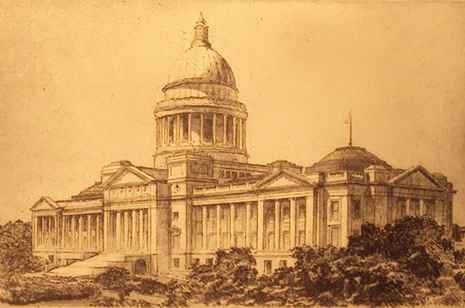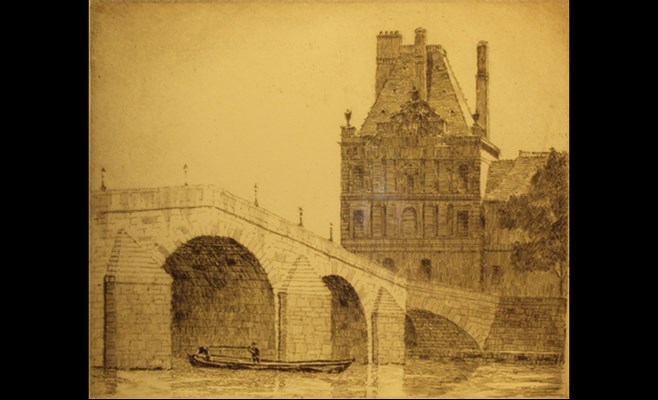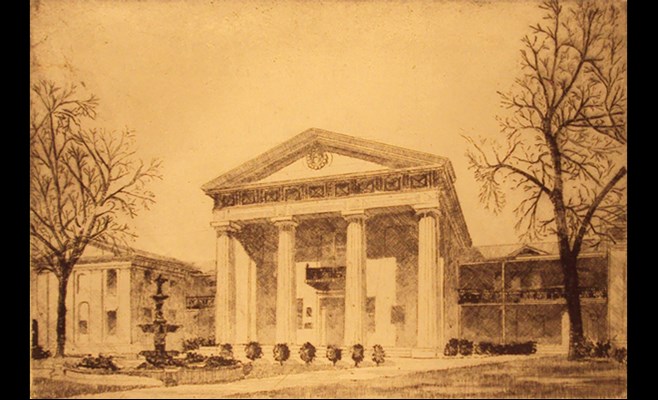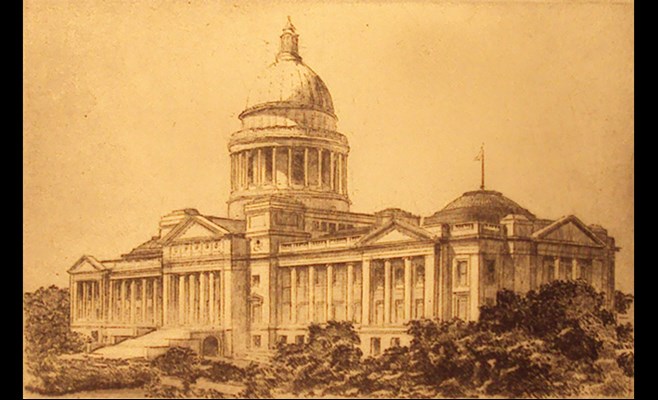George Francis Trapp: Prints from the Architect’s Sketchbook

“Arkansas State Capitol, Little Rock, Arkansas” by George Francis Trapp. (Intaglio print from George F. Trapp Collection, box 5, item 7. Special Collections, University of Arkansas Libraries, Fayetteville.)
FAYETTEVILLE, Ark. - An exhibit of intaglio prints by George Francis Trapp are on display in the lobby area of Mullins Library through the end of August. The works, many of which depict scenes Trapp drew while in Europe in the late 1920s, demonstrate Trapp's controlled but expressive style. His sensitivity to light and shade reveal the drama present in each work of architecture.
Trapp grew up in Little Rock and studied architecture at the University of Arkansas. After he received his Bachelor of Architecture from Columbia University in 1926, Trapp traveled to Europe and earned a diplôme from the prestigious cole des Beaux-Arts in Paris. Among his colleagues were Louis Skidmore and Arkansas-born Edward Durell Stone. Trapp recorded his travels in France and throughout Europe with finely crafted drawings of the sites he visited.
Following his time in Europe, Trapp moved to New York where he worked for Harvey Wiley Corbett, as did Edward Durell Stone. In 1934, Trapp returned to Arkansas. As a partner in the firm Trapp, Clippard and Phelps, Trapp was involved in the design of many significant buildings in Little Rock, including Robison Auditorium, Arkansas State Education Building, Pulaski Heights Presbyterian Church, and Hall High School. Although he was greatly affected by the European architecture he studied, the majority of Trapp's work fits more comfortably into a modernist idiom, with the exception of the neo-classical Robinson Auditorium.
After retirement, Trapp returned to intaglio printmaking, using the presses at the Arkansas Arts Center. Intaglio printmaking is a family of techniques where the design on the plate has been hollowed out. Trapp printed from new and older plates he made based on the drawings from his European travels. Trapp's prints were never sold; instead, they were given as gifts or donated to charities. His contributions were recognized by the Arkansas Chapter of the American Institute of Architects in 1971. He died on Feb. 18, 1980.
The prints in this exhibit are taken from a collection of sixty-four works, drawings and etchings donated to the University of Arkansas in 1983 by Trapp's widow, Linda Wiles Trapp. The works were exhibited at the university in 1983 and last exhibited in Little Rock in 1989. The works were recently added to the special collection's Arkansas Architectural Archive.
Topics
Contacts
Jennifer Rae Hartman , public relations coordinator
University Libraries
479-575-7253,
jrh002@uark.edu
Catherine Wallack , architectural records archivist
Special Collections
479-575-7253,
cwallack@uark.edu
Headlines
PetSmart CEO J.K. Symancyk to Speak at Walton College Commencement
J.K. Symancyk is an alumnus of the Sam M. Walton College of Business and serves on the Dean’s Executive Advisory Board.
Faulkner Center, Arkansas PBS Partner to Screen Documentary 'Gospel'
The Faulkner Performing Arts Center will host a screening of Gospel, a documentary exploring the origin of Black spirituality through sermon and song, in partnership with Arkansas PBS at 7:30 p.m. Thursday, May 2.
UAPD Officers Mills and Edwards Honored With New Roles
Veterans of the U of A Police Department, Matt Mills has been promoted to assistant chief, and Crandall Edwards has been promoted to administrative captain.
Community Design Center's Greenway Urbanism Project Wins LIV Hospitality Design Award
"Greenway Urbanism" is one of six urban strategies proposed under the Framework Plan for Cherokee Village, a project that received funding through an Our Town grant from the National Endowment for the Arts.
Spring Bike Drive Refurbishes Old Bikes for New Students
All donated bikes will be given to Pedal It Forward, a local nonprofit that will refurbish your bike and return it to the U of A campus to be gifted to a student in need. Hundreds of students have already benefited.








